Subscribe to P2P-economy
Stay up to date! Get all the latest & greatest posts delivered straight to your inbox
SubscribeThis simple guide will walk you through the steps of staking your Regen Network (REGEN) tokens using the Keplr wallet extension and/or Ledger wallet.
Regen Network is a network to enhance regenerative land management through an improved alignment of economic incentives.
Regen is a PoS network, meaning contributors can stake their REGEN tokens to contribute to the security of the network and earn staking rewards in the process of doing so.
1) Visit wallet.keplr.app using your Chrome browser, where you will be asked to connect your Keplr extension.
If you have registered the Regen Network address with Ledger, make sure that your firmware is up to date. To check, unlock your Ledger hardware wallet and open the Cosmos application.
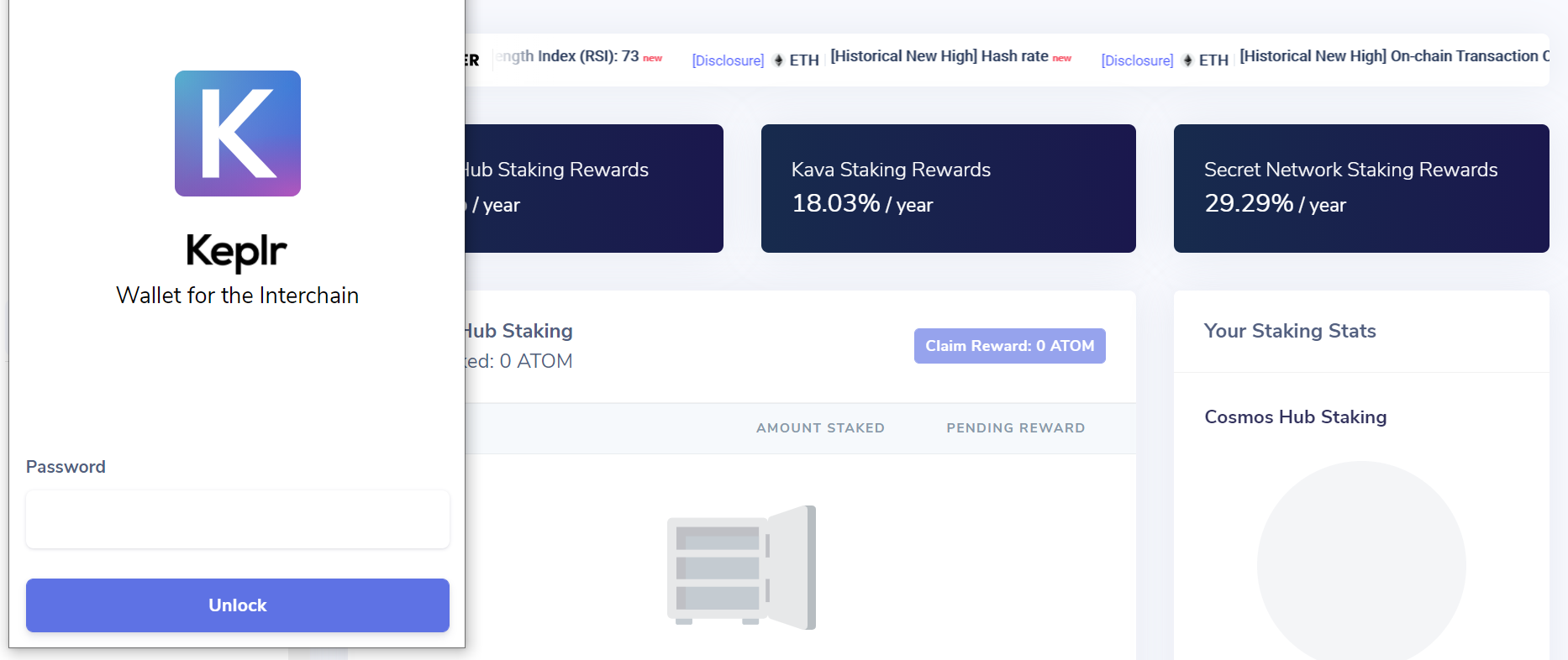
2) Login to your Keplr account. If you have multiple accounts click on the extension icon in the top right corner and select the account you used for Regen address registration.

3) Navigate to the Regen Network.
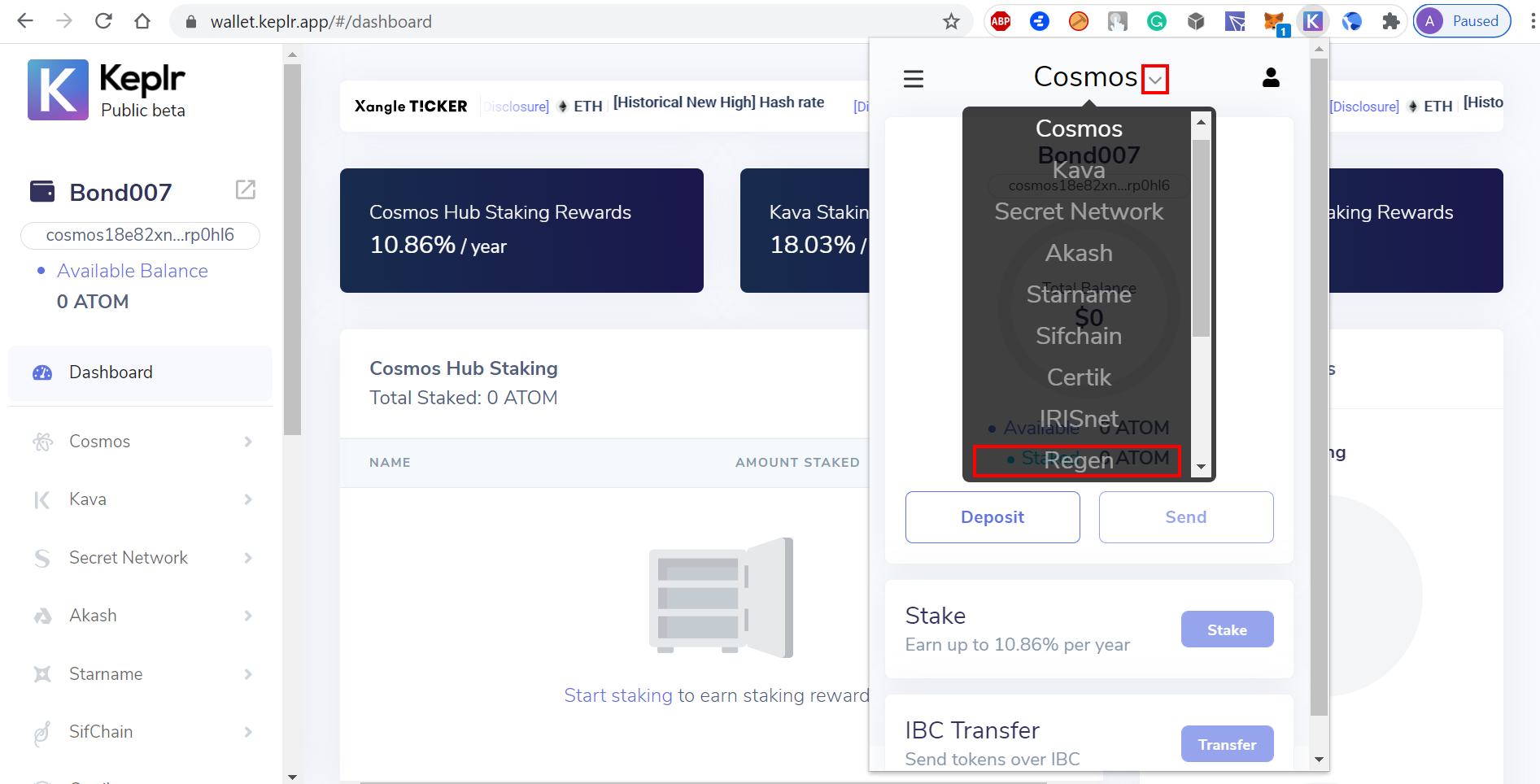
4) Press the Stake button.

5) On the Keplr dashboard, select P2P as the validator and click Manage.
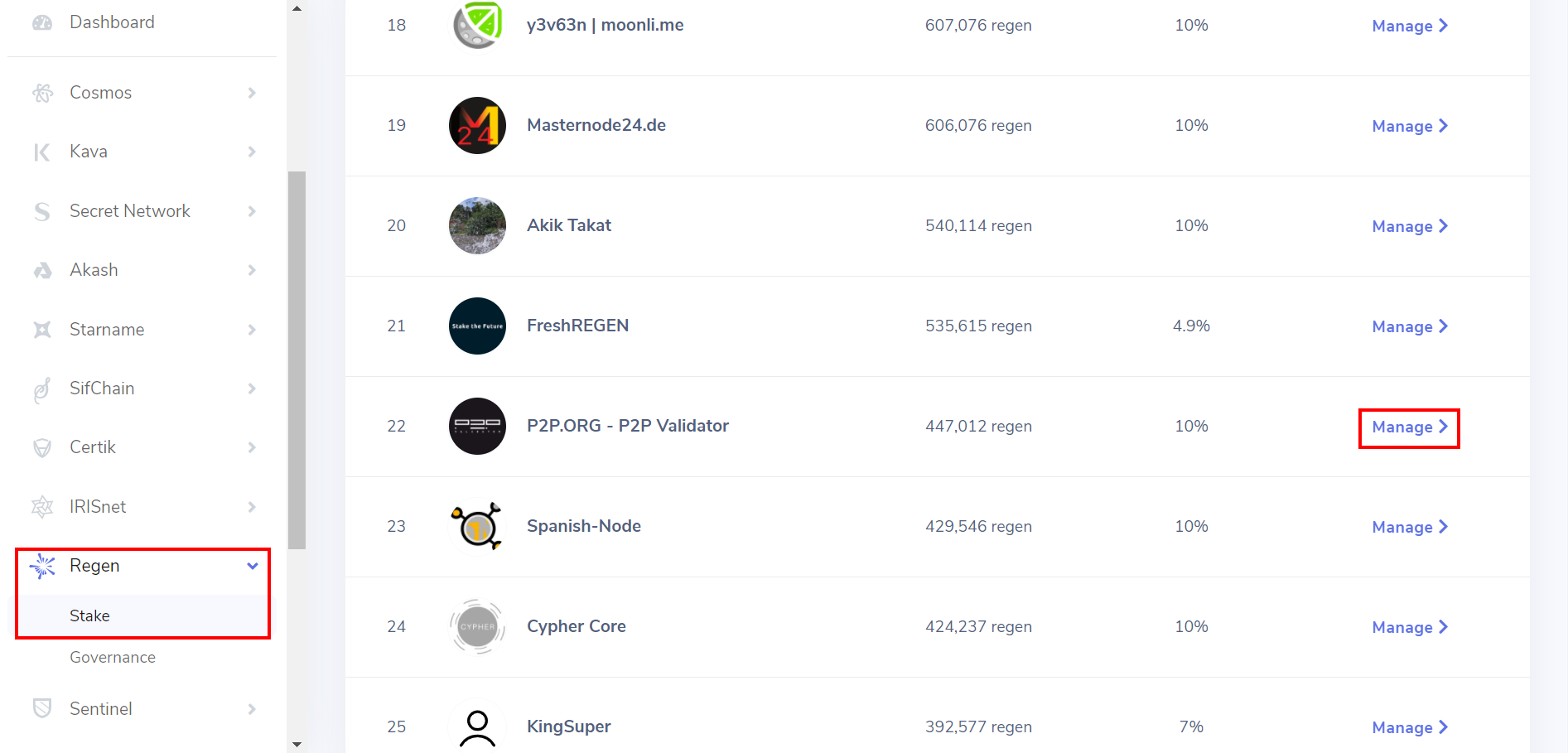
6) Click Delegate.
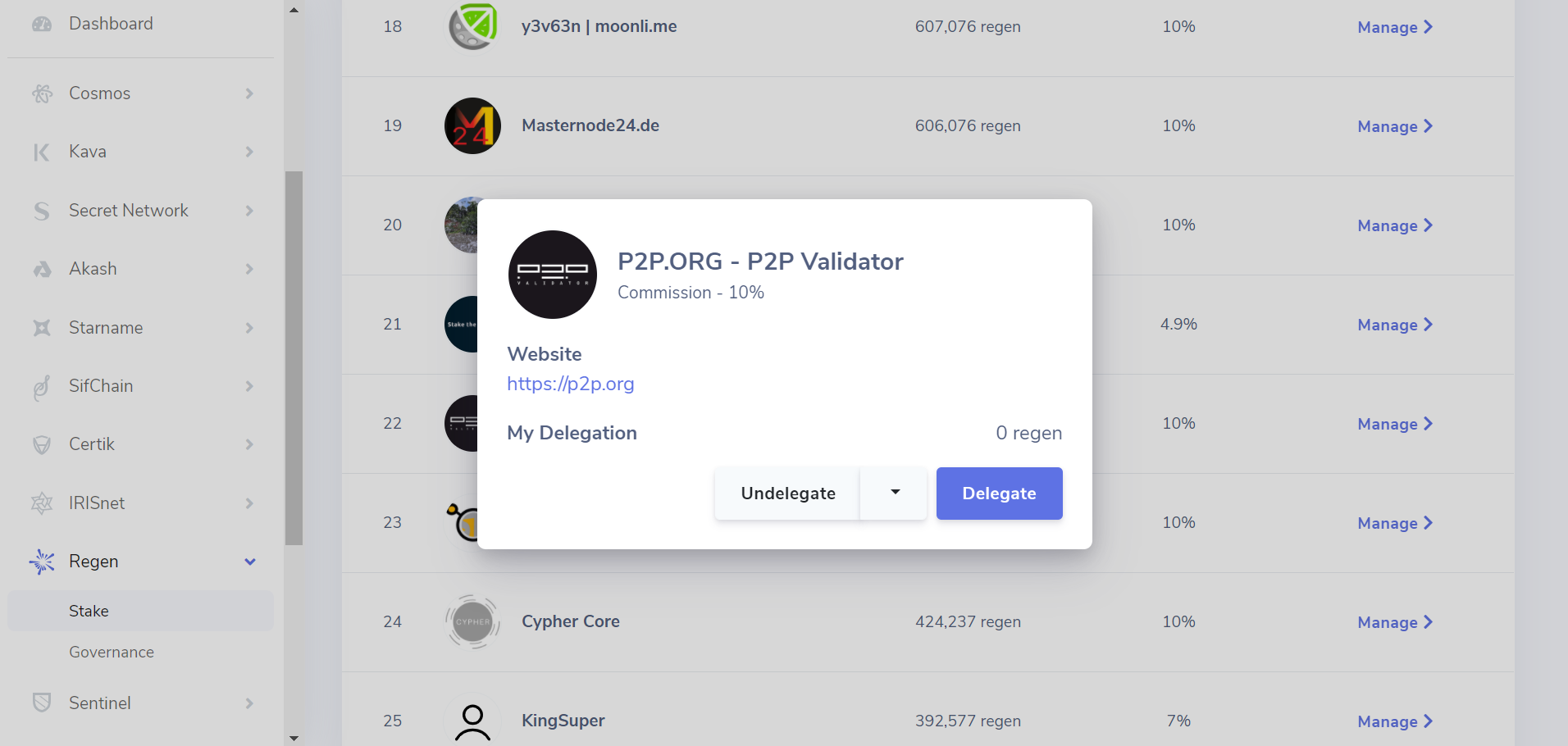
7) Specify the amount of REGEN to stake and press Delegate.
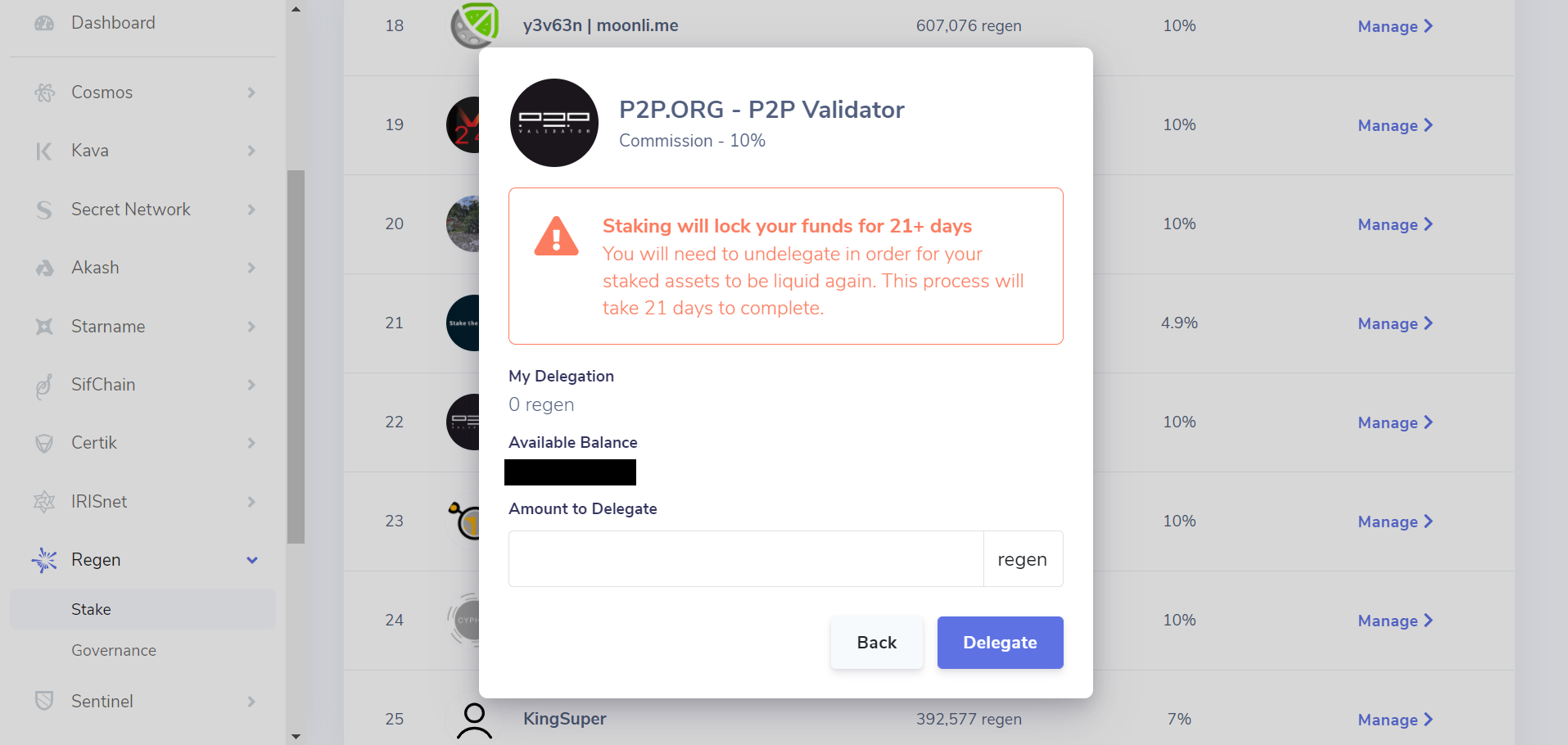
8) Select the transaction speed and approve it - wait for a confirmation.

Congratulations, you have successfully delegated your REGEN tokens. This contributes to the security of the Regen Network and allows you to earn staking rewards in the process. Staking rewards are accrued in real time and should be claimed manually to re-stake achieving compounding effect.
Do you have issues with REGEN staking? Join our Telegram, and we can help you get set up as a delegator.
P2P Validator is a world-leading staking provider with the best industry security practices and proven expertise. At the time of the latest update, over $3 billion of USD value is staked with P2P Validator by more than 10,000 delegators across 25+ networks. Our infrastructure is under advanced monitoring with alerts and 24/7 technical support making it the best choice for institutional investors. We have been involved in Regen Network testnets and invested own funds intending to provide long term support.
Web: p2p.org
Twitter: @p2pvalidator
LinkedIn: LinkedIn.com/company/p2p-org
Telegram: t.me/P2Pstaking
Research & Analytics at p2p.org.
<p><a href="https://p2p.org/near?ref=p2p.org">NEAR Protocol</a> is an open-source platform built to streamline the development and growth of decentralized applications (dApps). </p><p>NEAR is designed with security and performance at the core, allowing developers to create applications which manage high-value assets including money, identity and contractual information, whilst at the same time allowing for quick and efficient access. </p><p>With a focus on providing developers with a clean, user-friendly experience, NEARs approach to development is one focused around accessibility and scaling blockchain applications to accelerate the world’s transition to open, decentralized technologies. The protocol is a public, sharded, developer-friendly, proof-of-stake blockchain, making it an efficient platform due to its scalability and ease of use.</p><p>NEAR is compatible with Ethereum 1.0 today providing a complete integration with Solidity contracts (without the need for rewrites). Furthermore, an ETH-NEAR bridge allows for cross-chain interoperability and communication. This provides developers with flexibility and removes the need to fully commit to just one tech stack. </p><h2 id="market-size-potential">Market Size & Potential</h2><p>Near Protocol was launched in 2020 with a vision to give back control of financial assets and sensitive data to the users to which it belongs, with an ambition to build digital infrastructure for a new internet where evil actors are barred from manipulating it.</p><p>Similar to what has been developed by Ethereum and Polkadot, NEAR is a base-layer blockchain allowing for applications and programs to be built on top of it. Imagine Amazon’s AWS, except controlled by the NEAR community. </p><p>Through the use of <a href="https://near.org/blog/the-beginners-guide-to-the-near-blockchain/?ref=p2p.org">Sharding</a>, NEAR has a capacity to scale up significantly beyond the capabilities of existing blockchain solutions. Unlike with non-sharded networks, transaction fees on the NEAR network can be kept low due to congestion on the network being alleviated through dynamically expanding the system’s capacity via resharding.</p><h2 id="token-allocation-utility">Token Allocation & Utility</h2><p>The NEAR platform is built around NEAR - a token which enables holders to use, build and deploy applications, take part in the governance of the network and earn staking rewards in the process.</p><!--kg-card-begin: markdown--><p> </p> <!--kg-card-end: markdown--><figure class="kg-card kg-image-card"><img src="https://lh4.googleusercontent.com/RzQWj6MXQhRsAoLx2H9SwVaV0csfZ3IuJTF25tpNLZyVdd7W3rQcm1bFH7HDq0woP0xvXDnj0jr5yC8v3Tec1s4Y9WUkqNRDRWTzs-9BW7XFWB6LKD5E5MJv9XamXSEBQFtiLs-8" class="kg-image" alt loading="lazy"></figure><!--kg-card-begin: markdown--><p> </p> <!--kg-card-end: markdown--><p>The NEAR token sale was conducted in August 2020 with a fundraising goal of $12,500,000 which was successfully met. Investors include MetaStable, Electric Capital, Accomplice, SVAngel, Amplify and HomeBrew. </p><!--kg-card-begin: markdown--><p> </p> <!--kg-card-end: markdown--><figure class="kg-card kg-image-card"><img src="https://lh5.googleusercontent.com/QDO53uGsKFjvI_svYrUOV6y0DXL8PXBkJGViIPZ3mU2h0EUVkxxt5qahiDMkvNT65-YZcpDdo-XeyhjQT0lqnjGIDWRVJjracdZryC63zsh7GUswd4wEbQ6c3ZXnj7MUmeDBipvq" class="kg-image" alt loading="lazy"></figure><!--kg-card-begin: markdown--><p> </p> <!--kg-card-end: markdown--><p>The NEAR token is the manner in which users - developers, builders, community members, use applications on top of the NEAR network. By “use”, this refers to e.g. submitting transactions on the network. This makes the NEAR token an essential utility unit within the network.</p><p>The network utilises a “gas” model very similar to that deployed by Ethereum used to pay for transactions on chain. Through a “block-rewards-with-burn” model, NEAR supply decreases over time as token supply is burned with rates of high usage. The annual token emission is 5%, while the final inflation can fluctuate based on usage and transaction burns.</p><p>Even a negative inflation is a possibility based on the amount of fees burned. The effective inflation rate is calculated every epoch (½ a day). </p><p>NEAR validators are rewarded with a predetermined inflationary reward with incentives aligned to incentivise enhanced network usage through improving validator return rates and security.</p><h2 id="slashing-risk">Slashing Risk</h2><p>Currently slashing is turned off but it is considered to be added with an increase of shards in the system. </p><p>NEAR validators can be penalised in two primary ways resulting in a partial loss of a delegated stake:</p><ol><li>Double Signing: Signing two blocks at the same height.</li><li>Invalid Chunks: Producing a chunk with invalid data.</li></ol><p>These types of errors can occur for a number of reasons, both due to malicious intentions, as well as due to non-malicious errors or misconfigurations.</p><p>To better manage the risk of accidental slashing, NEAR network uses a progressive slashing system where the portion of slasked stake is a multiple of the amount of stake that exhibited the double signing behavior during the epoch in question.</p><h2 id="useful-near-resources">Useful NEAR Resources</h2><ul><li><a href="https://near.org/?ref=p2p.org">Website</a></li><li><a href="https://near.org/papers/the-official-near-white-paper?ref=p2p.org">Whitepaper</a></li><li><a href="https://near.org/blog/?ref=p2p.org">Blog</a></li><li><a href="https://github.com/near?ref=p2p.org">Github</a></li><li><a href="https://twitter.com/nearprotocol?ref=p2p.org">Twitter</a></li><li><a href="https://t.me/cryptonear?ref=p2p.org">Telegram</a></li></ul><p>To learn more about delegating NEAR with P2P, visit <a href="https://www.p2p.org/near?ref=p2p.org">www.p2p.org/near</a>. </p><h2 id="about-p2p-validator">About P2P Validator</h2><p><a href="https://p2p.org/?ref=p2p.org">P2P Validator</a> is a world-leading non-custodial staking provider securing more than $3 billion in staked assets by over 10,000 delegators across 25+ high-class networks. Our infrastructure is under advanced monitoring with alerts and 24/7 technical support making it the best choice for institutional investors.</p><hr><p><em><strong>Web</strong></em>: <a href="https://p2p.org/?ref=p2p.org">p2p.org</a><br><em><strong>Stake NEAR with us</strong></em>: <a href="https://p2p.org/near?ref=p2p.org">p2p.org/near</a><br><strong><em>Twitter</em></strong>: <a href="https://twitter.com/P2Pvalidator?ref=p2p.org">@p2pvalidator</a><br><em><strong>Telegram</strong></em>: <a href="https://t.me/P2Pstaking?ref=p2p.org">t.me/P2Pstaking</a></p>
from p2p validator
<p>The following is a step-by-step guide to transferring MPONDs earned in FlowMint stakedrop from Matic to Ethereum, and staking them using the Marlin network for an approximate APR of 10-12%.</p><h3 id="adding-mpond-to-metamask">Adding MPOND to MetaMask</h3><ol><li>To begin, you must <a href="https://p2p.org/economy/how-to-claim-mpond-during-flowmint-stakedrop/">harvest your MPOND</a> from FlowMint stakedrop.</li><li>To see your MPONDs on the MetaMask on Matic, add the MPOND token as a Custom Token in the MetaMask settings. To do so, navigate to MetaMask, click 'Add Token' and input the contract code below:</li></ol><p> MPOND contract - <strong>0x27B064fE4B708fDa0fD0C4ff2b78a1e4DAB812D1</strong>.</p><h3 id="transferring-mpond-from-matic-to-metamask">Transferring MPOND from Matic to MetaMask</h3><ol><li>To begin the process, go to <a href="https://wallet.matic.network/bridge?ref=p2p.org">wallet.matic.network/bridge</a> and connect your MetaMask using the Matic Network add-in.</li></ol><p>When prompted, select the following options:</p><ul><li><em>From Matic to Ethereum</em></li><li><em>Transfer Mode: PoS Bridge</em></li><li><em>Token: Marlin (Mpond)</em></li></ul><p>After configuring details, press Transfer.</p><figure class="kg-card kg-image-card"><img src="https://lh3.googleusercontent.com/-EPHar6mXzR9g4b_aUHtuwoYeNopbVCum-9xgKtG2oYHAogiNDx8kA39im7CPhDp08P9uywP7hMABMUWXYT2hyes8q2Xk-PUmsUW4ZsiWhdvCi4vXVUY4KfcZCBREuevG0iAeT57" class="kg-image" alt loading="lazy"></figure><p><br>After pressing transfer you will be prompted with a transaction overview screens. Press continue as in the screenshots pictured below. </p><figure class="kg-card kg-image-card"><img src="https://p2p.org/economy/content/images/2021/04/image-2.png" class="kg-image" alt loading="lazy" width="2000" height="915" srcset="https://p2p.org/economy/content/images/size/w600/2021/04/image-2.png 600w, https://p2p.org/economy/content/images/size/w1000/2021/04/image-2.png 1000w, https://p2p.org/economy/content/images/size/w1600/2021/04/image-2.png 1600w, https://p2p.org/economy/content/images/size/w2400/2021/04/image-2.png 2400w" sizes="(min-width: 720px) 720px"></figure><p>After confirming the transaction, you have to wait for the initialisation process. You can see the transaction status in the upper right corner. After a successful confirmation, you will pay fee in MATIC.</p><figure class="kg-card kg-image-card"><img src="https://p2p.org/economy/content/images/2021/04/image-1.png" class="kg-image" alt loading="lazy" width="2000" height="774" srcset="https://p2p.org/economy/content/images/size/w600/2021/04/image-1.png 600w, https://p2p.org/economy/content/images/size/w1000/2021/04/image-1.png 1000w, https://p2p.org/economy/content/images/size/w1600/2021/04/image-1.png 1600w, https://p2p.org/economy/content/images/size/w2400/2021/04/image-1.png 2400w" sizes="(min-width: 720px) 720px"></figure><p>Once the "Checkpoint" has arrived [see image on the right above], switch the network in the MetaMask settings from Matic to Ethereum and click Continue.</p><p>Sign the transaction on the Ethereum network to initiate the withdrawal of MPOND tokens from Matic to Ethereum.</p><figure class="kg-card kg-image-card"><img src="https://p2p.org/economy/content/images/2021/04/image-3.png" class="kg-image" alt loading="lazy" width="2000" height="1072" srcset="https://p2p.org/economy/content/images/size/w600/2021/04/image-3.png 600w, https://p2p.org/economy/content/images/size/w1000/2021/04/image-3.png 1000w, https://p2p.org/economy/content/images/size/w1600/2021/04/image-3.png 1600w, https://p2p.org/economy/content/images/size/w2400/2021/04/image-3.png 2400w" sizes="(min-width: 720px) 720px"></figure><p>After the transaction is signed, you will receive the MPOND tokens on the Ethereum network. To see the MPOND token in Metamask, use the MPOND contract address on the Ethereum network. </p><p>MPOND contract address: 0x1C77d15857646687005dbbAfFf5873F4495a9731</p><p>Now you can stake your MPOND tokens! </p><p>Use the following tutorial to <a href="https://p2p.org/economy/stake-pond-with-marlin/">stake your POND/MPOND tokens with P2P Validator</a>.</p><hr><p><strong><strong>If you have any questions, </strong>please stop by the<strong> </strong><a href="https://t.me/P2Pstaking?ref=p2p.org">P2P T<strong>elegram</strong></a>.</strong></p><hr><h3 id="about-p2p-validator"><strong>About P2P Validator</strong></h3><p>P2P Validator is a world-leading non-custodial staking provider securing more than $3.2 billion from over 10,000 delegators across 25+ high-class staking networks. </p><h3 id="learn-more-">Learn more:</h3><p><strong>Web</strong>: <a href="https://p2p.org/?utm_source=blog&utm_campaign=sol_guide">p2p.org</a><br><strong>Twitter</strong>: <a href="https://twitter.com/P2Pvalidator?ref=p2p.org">@p2pvalidator</a><br><strong>LinkedIn</strong>: <a href="https://www.linkedin.com/company/p2p-org/?ref=p2p.org">linkedin.com/company/p2p-org</a><br><strong>Telegram</strong>: <a href="https://t.me/P2Pstaking?ref=p2p.org">t.me/P2Pstaking</a></p>
from p2p validator